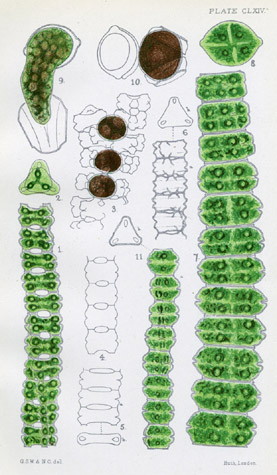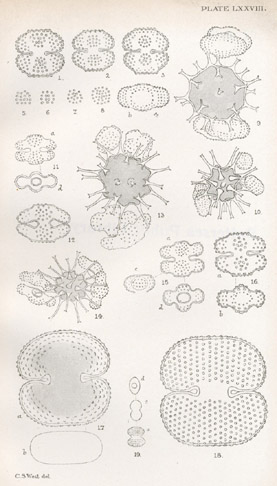 Desmid image database
Desmid image database
Introduction
This database represents the public face of RBGE's desmid database, designed by R.J. Pankhurst as an implementation of Advanced Revelation, and further developed by Martin Pullan. The so-called 'Pandora' databases (of which there are several at RBGE and elsewhere) are very sophisticated in the relational way they handle data but, because they are DOS-based, are not very easy or attractive for the uninitiated to use. For this and several other reasons, it was decided that the best way to make the data available to a wider audience was to create a series of flat-field data dumps from the Pandora database; these could then be interrogated using a web browser. The search-engines required for this have been created by Martin Pullan, using the home-grown data-extraction software HTMLexport.
From here on we will refer only to the web-based database, but remember that it is several steps removed from the Pandora database that has provided its data.
Structure of the database
The database is very similar in structure to that produced by Martin Pullan and Micha Bayer (who no longer works at RBGE) for the ADIAC project, although there are some differences: ADIAC was concerned primarily with photographs of microalgae (diatoms, as it happened), whereas DIADIST, at least in these early stages, is more concerned with published drawings of microalgae (primarily desmids at this stage).
The desmid database is built on a taxonomic framework consisting of all the names in West & West's British Desmidiaceae, updated to more modern nomenclature and supplemented from Brook & Williamson (1991), with a few extra changes or additions from John et al. (2002).
Onto this framework are the images that you can find here. We have started with the drawings from West & West's British Desmidiaceae, either as whole browsable plates or individually scanned drawings. Ultimately we will also incorporate photographs of desmids, and hope soon to develop the techniques to allow dynamic focusing of images as has been done in ordinary web pages (as distinct from pages resulting from search-engine queries) in our Algae World website (follow links to 'Research' and 'Types').
 Current status
Current status